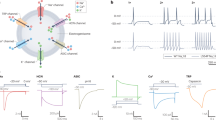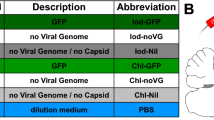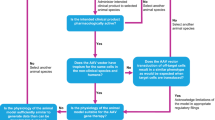Abstract
Recombinant adeno-associated virus (rAAV) vectors consisting of self-complementary genomes and packaged in certain capsids can target primary sensory neurons efficiently and can control neuropathic pain long term by expressing opioid or non-opioid analgesic genes. This review examines the therapeutic potential of the approach in five sections: Pain control in oncology (including a discussion of cancer centers as translational pain research environment); vector biology; safety considerations and immunological lessons learned from rAAV clinical trials of other disorders; development of intrathecal rAAV therapy in rodent models of pain; and preclinical steps towards clinical translation of rAAV for pain. In the field of analgesic drug development, clinical validation of new approaches identified in rodents is currently a critical limiting step. Small-molecule therapeutics suitable as conventional drugs to probe novel targets in clinical trials are often unavailable. In this context, gene therapy could fill an important gap in the drug development process facilitating first-into-human trials of untested targeted treatments, each instantiated as a therapeutic gene.
This is a preview of subscription content, access via your institution
Access options
Subscribe to this journal
Receive 12 print issues and online access
$259.00 per year
only $21.58 per issue
Buy this article
- Purchase on Springer Link
- Instant access to full article PDF
Prices may be subject to local taxes which are calculated during checkout
Similar content being viewed by others
References
National Institutes of Health. Program Announcement (PA) Number: PA-07-282 ‘Mechanisms, Models, Measurement, & Management in Pain Research (R01)’. National Institutes of Health: Bethesda, MD, 2007.
Cleeland CS, Gonin R, Hatfield AK, Edmonson JH, Blum RH, Stewart JA et al. Pain and its treatment in outpatients with metastatic cancer. N Engl J Med 1994; 330: 592–596.
Larue F, Colleau SM, Brasseur L, Cleeland CS . Multicentre study of cancer pain and its treatment in France. BMJ 1995; 310: 1034–1037.
Mercadante S . Pain treatment and outcomes for patients with advanced cancer who receive follow-up care at home. Cancer 1999; 85: 1849–1858.
Zech DF, Grond S, Lynch J, Hertel D, Lehmann KA . Validation of World Health Organization Guidelines for cancer pain relief: a 10-year prospective study. Pain 1995; 63: 65–76.
Caraceni A, Portenoy RK . An international survey of cancer pain characteristics and syndromes. IASP Task Force on Cancer Pain. International Association for the Study of Pain. Pain 1999; 82: 263–274.
Meuser T, Pietruck C, Radbruch L, Stute P, Lehmann KA, Grond S . Symptoms during cancer pain treatment following WHO-guidelines: a longitudinal follow-up study of symptom prevalence, severity and etiology. Pain 2001; 93: 247–257.
Weiss SC, Emanuel LL, Fairclough DL, Emanuel EJ . Understanding the experience of pain in terminally ill patients. Lancet 2001; 357: 1311–1315.
Adams K, Corrigan J . Priority Areas for National Action. National Academies Press: Washington, DC, 2003.
World Health Organization. Cancer Pain Relief. World Health Organization: Geneva, Switzerland, 1986.
Portenoy RK . Pharmacologic management of cancer pain. Semin Oncol 1995; 22: 112–120.
Levy MH . Pharmacologic treatment of cancer pain. N Engl J Med 1996; 335: 1124–1132.
Jacox A, Carr D, Payne R . Management of cancer pain: Clinical Practice Guideline Number 9—AHCPR publications 94-0592. Agency for Health Care Policy and Research, US Department of Health and Human Services, Public Health Service: Rockville, MD, 1994.
Foley K . A 44-year-old woman with severe pain at the end of life. JAMA 1999; 281: 1937–1945.
Blacklow NR, Hoggan MD, Kapikian AZ, Austin JB, Rowe WP . Epidemiology of adenovirus-associated virus infection in a nursery population. Am J Epidemiol 1968; 88: 368–378.
Blacklow NR, Hoggan MD, Rowe WP . Serologic evidence for human infection with adenovirus-associated viruses. J Natl Cancer Inst 1968; 40: 319–327.
Chirmule N, Propert K, Magosin S, Qian Y, Qian R, Wilson J . Immune responses to adenovirus and adeno-associated virus in humans. Gene Therapy 1999; 6: 1574–1583.
Erles K, Sebokova P, Schlehofer JR . Update on the prevalence of serum antibodies (IgG and IgM) to adeno- associated virus (AAV). J Med Virol 1999; 59: 406–411.
Storek B, Harder NM, Banck MS, Wang C, McCarty DM, Janssen WG et al. Intrathecal long-term gene expression by self-complementary adeno-associated virus type 1 suitable for chronic pain studies in rats. Mol Pain 2006; 2: 4.
Storek B, Reinhardt M, Wang C, Janssen WG, Harder NM, Banck MS et al. Sensory neuron targeting by self-complementary AAV8 via lumbar puncture for chronic pain. Proc Natl Acad Sci USA 2008; 105: 1055–1060.
Milligan ED, Sloane EM, Langer SJ, Cruz PE, Chacur M, Spataro L et al. Controlling neuropathic pain by adeno-associated virus driven production of the anti-inflammatory cytokine, interleukin-10. Mol Pain 2005; 1: 9.
Wright JF . Manufacturing and characterizing AAV-based vectors for use in clinical studies. Gene Therapy 2008; 15: 840–848.
Cecchini S, Negrete A, Kotin RM . Toward exascale production of recombinant adeno-associated virus for gene transfer applications. Gene Therapy 2008; 15: 823–830.
Negrete A, Kotin RM . Large-scale production of recombinant adeno-associated viral vectors. Methods Mol Biol 2008; 433: 79–96.
Negrete A, Kotin RM . Strategies for manufacturing recombinant adeno-associated virus vectors for gene therapy applications exploiting baculovirus technology. Brief Funct Genomic Proteomic 2008; 7: 303–311.
McCarty DM, Fu H, Monahan PE, Toulson CE, Naik P, Samulski RJ . Adeno-associated virus terminal repeat (TR) mutant generates self-complementary vectors to overcome the rate-limiting step to transduction in vivo. Gene Therapy 2003; 10: 2112–2118.
Zhong L, Li B, Jayandharan G, Mah CS, Govindasamy L, Agbandje-McKenna M et al. Tyrosine-phosphorylation of AAV2 vectors and its consequences on viral intracellular trafficking and transgene expression. Virology 2008; 381: 194–202.
Zhong L, Li B, Mah CS, Govindasamy L, Agbandje-McKenna M, Cooper M et al. Next generation of adeno-associated virus 2 vectors: point mutations in tyrosines lead to high-efficiency transduction at lower doses. Proc Natl Acad Sci USA 2008; 105: 7827–7832.
Allocca M, Doria M, Petrillo M, Colella P, Garcia-Hoyos M, Gibbs D et al. Serotype-dependent packaging of large genes in adeno-associated viral vectors results in effective gene delivery in mice. J Clin Invest 2008; 118: 1955–1964.
Smith RH . Adeno-associated virus integration: virus versus vector. Gene Therapy 2008; 15: 817–822.
Donsante A, Vogler C, Muzyczka N, Crawford JM, Barker J, Flotte T et al. Observed incidence of tumorigenesis in long-term rodent studies of rAAV vectors. Gene Ther 2001; 8: 1343–1346.
Donsante A, Miller DG, Li Y, Vogler C, Brunt EM, Russell DW et al. AAV vector integration sites in mouse hepatocellular carcinoma. Science 2007; 317: 477.
Bell P, Moscioni AD, McCarter RJ, Wu D, Gao G, Hoang A et al. Analysis of tumors arising in male B6C3F1 mice with and without AAV vector delivery to liver. Mol Ther 2006; 14: 34–44.
Lo WD, Qu G, Sferra TJ, Clark R, Chen R, Johnson PR . Adeno-associated virus-mediated gene transfer to the brain: duration and modulation of expression. Hum Gene Ther 1999; 10: 201–213.
Kaplitt MG, Feigin A, Tang C, Fitzsimons HL, Mattis P, Lawlor PA et al. Safety and tolerability of gene therapy with an adeno-associated virus (AAV) borne GAD gene for Parkinson's disease: an open label, phase I trial. Lancet 2007; 369: 2097–2105.
Marks Jr WJ, Ostrem JL, Verhagen L, Starr PA, Larson PS, Bakay RA et al. Safety and tolerability of intraputaminal delivery of CERE-120 (adeno-associated virus serotype 2-neurturin) to patients with idiopathic Parkinson's disease: an open-label, phase I trial. Lancet Neurol 2008; 7: 400–408.
Worgall S, Sondhi D, Hackett NR, Kosofsky B, Kekatpure MV, Neyzi N et al. Treatment of late infantile neuronal ceroid lipofuscinosis by CNS administration of a serotype 2 adeno-associated virus expressing CLN2 cDNA. Hum Gene Ther 2008; 19: 463–474.
Herzog RW . Immune responses to AAV capsid: are mice not humans after all? Mol Ther 2007; 15: 649–650.
Zaiss AK, Muruve DA . Immunity to adeno-associated virus vectors in animals and humans: a continued challenge. Gene Therapy 2008; 15: 808–816.
Mingozzi F, High KA . Immune responses to AAV in clinical trials. Curr Gene Ther 2007; 7: 316–324.
Manno CS, Pierce GF, Arruda VR, Glader B, Ragni M, Rasko JJ et al. Successful transduction of liver in hemophilia by AAV-Factor IX and limitations imposed by the host immune response. Nat Med 2006; 12: 342–347.
Mingozzi F, Maus MV, Hui DJ, Sabatino DE, Murphy SL, Rasko JE et al. CD8(+) T-cell responses to adeno-associated virus capsid in humans. Nat Med 2007; 13: 419–422.
Li H, Murphy SL, Giles-Davis W, Edmonson S, Xiang Z, Li Y et al. Pre-existing AAV capsid-specific CD8+ T cells are unable to eliminate AAV-transduced hepatocytes. Mol Ther 2007; 15: 792–800.
Lowenstein PR, Mandel RJ, Xiong WD, Kroeger K, Castro MG . Immune responses to adenovirus and adeno-associated vectors used for gene therapy of brain diseases: the role of immunological synapses in understanding the cell biology of neuroimmune interactions. Curr Gene Ther 2007; 7: 347–360.
Lowenstein PR, Kroeger K, Castro MG . Immunology of neurological gene therapy: how T cells modulate viral vector-mediated therapeutic transgene expression through immunological synapses. Neurotherapeutics 2007; 4: 715–724.
Thomas CE, Birkett D, Anozie I, Castro MG, Lowenstein PR . Acute direct adenoviral vector cytotoxicity and chronic, but not acute, inflammatory responses correlate with decreased vector-mediated transgene expression in the brain. Mol Ther 2001; 3: 36–46.
Driesse MJ, Esandi MC, Kros JM, Avezaat CJ, Vecht C, Zurcher C et al. Intra-CSF administered recombinant adenovirus causes an immune response-mediated toxicity. Gene Therapy 2000; 7: 1401–1409.
Driesse MJ, Kros JM, Avezaat CJ, Valerio D, Vecht CJ, Bout A et al. Distribution of recombinant adenovirus in the cerebrospinal fluid of nonhuman primates. Hum Gene Ther 1999; 10: 2347–2354.
Janson C, McPhee S, Bilaniuk L, Haselgrove J, Testaiuti M, Freese A et al. Clinical protocol. Gene therapy of Canavan disease: AAV-2 vector for neurosurgical delivery of aspartoacylase gene (ASPA) to the human brain. Hum Gene Ther 2002; 13: 1391–1412.
Eberling JL, Jagust WJ, Christine CW, Starr P, Larson P, Bankiewicz KS et al. Results from a phase I safety trial of hAADC gene therapy for Parkinson disease. Neurology 2008; 70: 1980–1983.
Bainbridge JW, Smith AJ, Barker SS, Robbie S, Henderson R, Balaggan K et al. Effect of gene therapy on visual function in Leber's congenital amaurosis. N Engl J Med 2008; 358: 2231–2239.
Maguire AM, Simonelli F, Pierce EA, Pugh Jr EN, Mingozzi F, Bennicelli J et al. Safety and efficacy of gene transfer for Leber's congenital amaurosis. N Engl J Med 2008; 358: 2240–2248.
Cideciyan AV, Aleman TS, Boye SL, Schwartz SB, Kaushal S, Roman AJ et al. Human gene therapy for RPE65 isomerase deficiency activates the retinoid cycle of vision but with slow rod kinetics. Proc Natl Acad Sci USA 2008; 105: 15112–15117.
Hauswirth W, Aleman TS, Kaushal S, Cideciyan AV, Schwartz SB, Wang L et al. Phase I trial of leber congenital amaurosis due to RPE65 mutations by ocular subretinal injection of adeno-associated virus gene vector: short-term results. Hum Gene Ther (in press).
Smith TJ, Staats PS, Deer T, Stearns LJ, Rauck RL, Boortz-Marx RL et al. Randomized clinical trial of an implantable drug delivery system compared with comprehensive medical management for refractory cancer pain: impact on pain, drug-related toxicity, and survival. J Clin Oncol 2002; 20: 4040–4049.
Natkunarajah M, Trittibach P, McIntosh J, Duran Y, Barker SE, Smith AJ et al. Assessment of ocular transduction using single-stranded and self-complementary recombinant adeno-associated virus serotype 2/8. Gene Therapy 2008; 15: 463–467.
Chung JM, Kim HK, Chung K . Segmental spinal nerve ligation model of neuropathic pain. Methods Mol Med 2004; 99: 35–45.
Beutler AS, Banck MS, Bach FW, Gage FH, Porreca F, Bilsky EJ et al. Retrovirus-mediated expression of an artificial beta-endorphin precursor in primary fibroblasts. J Neurochem 1995; 64: 475–481.
Finegold AA, Mannes AJ, Iadarola MJ . A paracrine paradigm for in vivo gene therapy in the central nervous system: treatment of chronic pain. Hum Gene Ther 1999; 10: 1251–1257.
Beutler AS, Banck MS, Walsh CE, Milligan ED . Intrathecal gene transfer by adeno-associated virus for pain. Curr Opin Mol Ther 2005; 7: 431–439.
Allen JW, Mantyh PW, Horais K, Tozier N, Rogers SD, Ghilardi JR et al. Safety evaluation of intrathecal substance P-saporin, a targeted neurotoxin, in dogs. Toxicol Sci 2006; 91: 286–298.
Xu Y, Gu Y, Xu GY, Wu P, Li GW, Huang LY . Adeno-associated viral transfer of opioid receptor gene to primary sensory neurons: a strategy to increase opioid antinociception. Proc Natl Acad Sci USA 2003; 100: 6204–6209.
Kaspar BK, Llado J, Sherkat N, Rothstein JD, Gage FH . Retrograde viral delivery of IGF-1 prolongs survival in a mouse ALS model. Science 2003; 301: 839–842.
Acknowledgements
We thank Dr Stephen Russell for discussions. This work was supported by Research Grants K08NS046012 and 1R01NS063022 to ASB from the National Institute of Neurological Disorders and Stroke.
Author information
Authors and Affiliations
Corresponding author
Rights and permissions
About this article
Cite this article
Beutler, A., Reinhardt, M. AAV for pain: steps towards clinical translation. Gene Ther 16, 461–469 (2009). https://doi.org/10.1038/gt.2009.23
Received:
Accepted:
Published:
Issue Date:
DOI: https://doi.org/10.1038/gt.2009.23
Keywords
This article is cited by
-
Sigma-1 receptor activity in primary sensory neurons is a critical driver of neuropathic pain
Gene Therapy (2022)
-
Current Gene Therapy using Viral Vectors for Chronic Pain
Molecular Pain (2015)
-
A compact dual promoter adeno-associated viral vector for efficient delivery of two genes to dorsal root ganglion neurons
Gene Therapy (2014)
-
Lentiviral Gene Transfer into the Dorsal Root Ganglion of Adult Rats
Molecular Pain (2011)
-
AAV Provides an Alternative for Gene Therapy of the Peripheral Sensory Nervous System
Molecular Therapy (2010)



